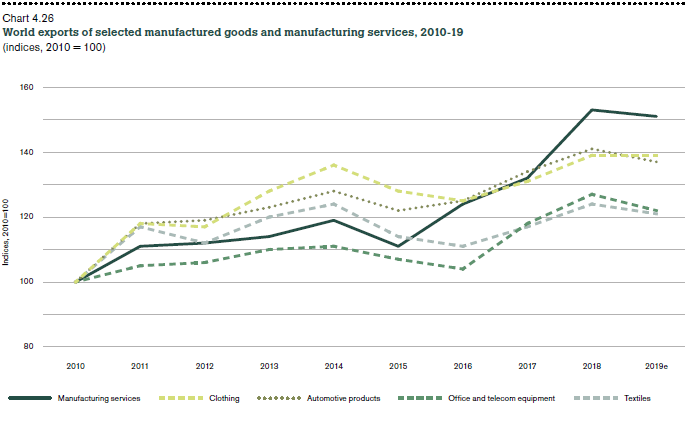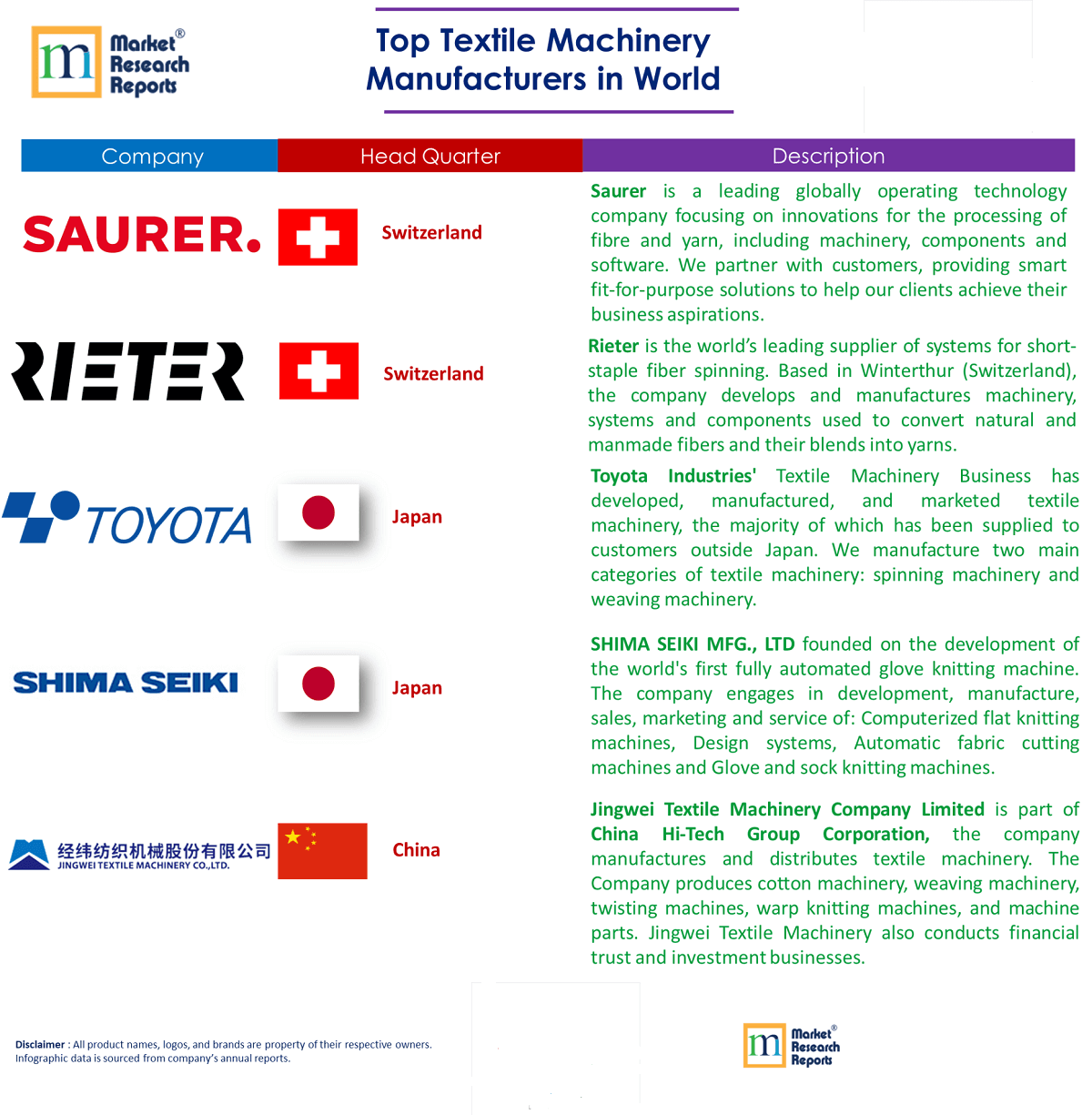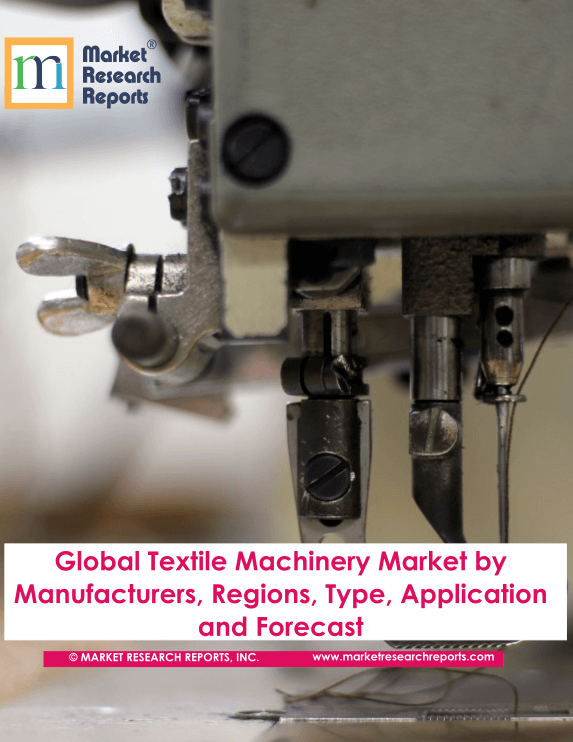Global Textile Machinery Major Vendors, Market Status and Projection

The economic slowdown in major economies, burdened with weaker demand, has adversely affected the manufacturing of textiles and clothing. The figures presented by WTO have reported that exports were stagnated in 2019. The textile segment is part of fashion value chains, in which the production of garments takes place in various countries, thus affecting exports of manufacturing services.

Source: WTO International Trade Statistics
Especially in the textile machinery segment, there are a number of post-pandemic challenges. The post-COVID scenario still not clear in many countries. In different countries, the pandemic is in different stages and the fear of the second wave still looming. In the early days of the pandemic, many governments, for example, textile machine manufacturing leader, Switzerland has offered various support services to the ailing industry. In Switzerland, for example, short-time working was made possible in no time. Moreover, a conducive environment was very quickly envisaged for companies to obtain credit at 0% interest. However, this assistance is now being reduced step by step. Accordingly, many companies expect Q4 2020 and Q1 2021 to become even more difficult.
Impact of COVID on the Textile Industry Value Chain
In all segments of the global textile value chain, orders are down in the range of -37% to -46%. Turnover 2020 is down in the range of -26% to -34% compared to 2019.

Leading Textile Machinery Manufacturers in World
 Textile Machinery Shipments and Market Forecast
Textile Machinery Shipments and Market Forecast
Shipments of large circular machines contracted by 1.2%, while shipped flat knitting machines fell by 40%. The sum of deliveries in the finishing segment also dropped by 2% on average.
The total number of shipped short-staple spindles decreased by about 1.7 million units in 2019 to a level of 6.96 million. Most of the new short-staple spindles (92%) were shipped to Asia & Oceania, where delivery decreased by 20%. While levels stayed relatively small, Africa and South America saw shipments increasing by 150% and 120%, respectively. The six largest investors in the short-staple segment were China, India, Uzbekistan, Vietnam, Pakistan, and Bangladesh.
Global shipments of single heater draw-texturing spindles (mainly used for polyamide filaments) increased by 12% from nearly 22,800 in 2018 to 25,500 in 2019. With a share of 88%, Asia & Oceania was the strongest destination for single heater draw- texturing spindles. China and Chinese Taipei were the main investors in this segment with a share of 64% and 12% of global deliveries, respectively.
Global shipments of large diameter circular knitting machines fell by 1.2% to 26,400 units in 2019. The region Asia & Oceania was the world’s leading investor in this category with 86% of worldwide shipments. With 61% of all deliveries (i.e. 13,143 units), China was the favoured destination. India and Vietnam ranked second and third with 2,670 and 2,210 units, respectively.
In 2019, the segment of electronic flat knitting machines decreased by 40% to around 96,000 machines. Asia & Oceania was the main destination for these machines with a share of 92% of world shipments. China remained the world’s largest investor with an 80% share despite a 44%-decrease in investments from 122,550 units to 68,760 units.
Weaving Machinery
In 2019, worldwide shipments of shuttle-less looms decreased by 0.6% to 133,250 units. Thereby, shipments in the categories of ‘air-jet’ and ‘rapier and projectile’ fell by 7.7% to 30,200 and 22% to 25,000, respectively. Deliveries of water-jet looms increased by +12% to 78’000. The main destination for shuttle-less looms in 2019 was Asia & Oceania with 95% of all worldwide deliveries. 98%, 93%, 86% of all water-jet, air-jet, and rapier/projectile looms went to that region. The main investors were China and India in all three sub-categories. Deliveries of weaving machines to these two countries reached 89% of total deliveries. Bangladesh further played an important role in the rapier/projectile segment with 20% of global shipments.
Finishing Machinery
In the ‘fabrics continuous’ segment, shipments of stenters and washing (stand-alone) grew by 34% and 0.6%. The growth in stenter deliveries is mainly explained by the addition of ITMF’s estimate for the number of stenters. The total number of shipped stenters of 1,700 units thus represents an estimate of the total market for this category.
In the ‘fabrics discontinuous’ segment, the number of jigger dyeing / beam dyeing machines shipped rose by 35% to 561 units. Deliveries in all other machine categories in both finishing sub-segments (i.e. continuous and discontinuous) decreased in 2019.






